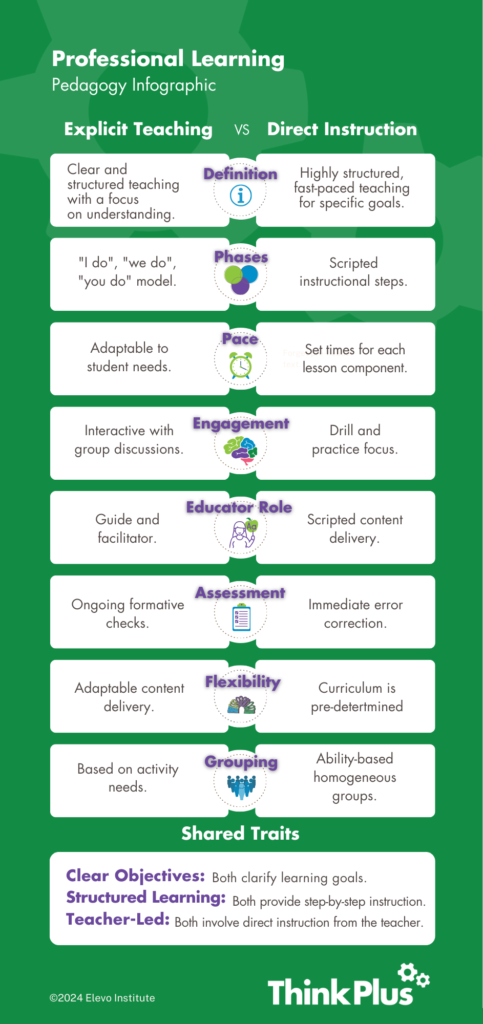by Celia Franzè
Explicit Teaching and Direct Instruction are both highly effective, teacher-led approaches that rely on clarity and structure. However, the rigidity and pacing of Direct Instruction set it apart from the more adaptable Explicit Teaching method. As educators, understanding the nuances of each can help in selecting the right approach for the students’ needs, ensuring that every learner is given the best opportunity to succeed.
Educators often navigate a plethora of instructional strategies, with Explicit Teaching and Direct Instruction being two methods that are frequently compared and contrasted. While they share a number of characteristics, they also have distinct features that set them apart. Let’s break down these two pedagogical approaches.
Criteria |
Explicit Teaching |
Direct Instruction |
| Definition | A teaching method that is clear, unambiguous, and direct, focusing on structured steps to promote understanding. | A structured, sequenced form of teaching that is highly scripted and includes fast-paced lessons targeted at specific learning goals. |
| Key Phases | The instructional process generally follows the “I do”, “we do”, “you do” model, allowing for gradual release of responsibility. | Comprises a more rigorous and scripted sequence of instructional steps, often including scripted lessons and immediate feedback. |
| Learning Goals | The goals are clearly defined and communicated at the start of the lesson. | Goals are specific, measurable, and often broken down into smaller, sequential objectives. |
| Student Engagement | Typically encourages interactive learning with questions and group discussions. | Focuses more on drill and practice with less emphasis on discussion, fostering quick and accurate responses to questions. |
| Pace of Instruction | Pace can vary, often adjusted according to student needs and understanding. | Fast-paced with a set time for each component to ensure all content is covered within the lesson or unit. |
| Teacher Role | The teacher guides students through stages of understanding, often adapting to the class’s needs. | The teacher delivers content in a highly structured manner, following a specific script or format. |
| Assessment | Formative assessment is used throughout to check understanding and inform the next stages of instruction. | Frequent assessments are integral, with the goal of correcting errors immediately and ensuring mastery before moving on. |
| Content Delivery | Content is broken down into clear, manageable chunks to facilitate understanding. | Content is systematically broken down into small steps, each building upon the previous one. |
| Scaffolding | Scaffolding is provided through modeling, guided practice, and feedback. | Scaffolding is inherent in the scripted sequences and the design of the instructional materials. |
| Flexibility | There is flexibility to modify the approach based on the learners’ responses. | Less flexible, as the curriculum is often pre-determined and follows a strict sequence. |
| Grouping of Students | Students may be grouped based on the activity or learning needs during the guided practice. | Students are grouped primarily by ability and are taught in homogeneous groups. |
| Similarities | Both aim to make learning objectives clear, provide structured learning experiences, and involve a high level of teacher-led instruction. | Both aim to make learning objectives clear, provide structured learning experiences, and involve a high level of teacher-led instruction. |
ThinkPlus Infographic:
More about Direct Instruction
Direct Instruction (DI) is an educational approach developed by Siegfried Engelmann in the 1960s, emphasising the precise, tailored teaching to meet individual student needs. Initially devised from Engelmann’s work in advertising, the principles of DI were applied to his own children’s learning, leading to the foundation of the Bereiter-Engelmann preschool. This model pivots on the belief that a student’s failure to learn is an indication of insufficient instruction, not a student’s incapacity.
Engelmann’s method stresses the importance of mastering each concept before progressing to more complex ones. He introduced small-group learning based on skill levels, rather than age or grade, to ensure that students have a thorough understanding and confidence in their abilities. This mastery-based approach was specifically designed to help at-risk students close the achievement gap with their peers by the end of elementary school.
The legacy of Engelmann’s Direct Instruction lives on, significantly shaping educational practices and curricula through programs like DISTAR (Direct Instruction System for Teaching Arithmetic and Reading). His work underpins the vital role of effective and efficient teaching in recognising and fostering students’ potential, irrespective of their background or abilities, ensuring that every child has the opportunity to succeed academically.
More about How Students Learn Best and Explicit Teaching from AERO
Australian Education Research Organisation. (2023). How students learn best. https://www.edresearch.edu.au/resources/how-students-learn-best
Australian Education Research Organisation. (2024). Teach explicitly. https://www.edresearch.edu.au/sites/default/files/2024-02/teach-explicitly-aa.pdf
